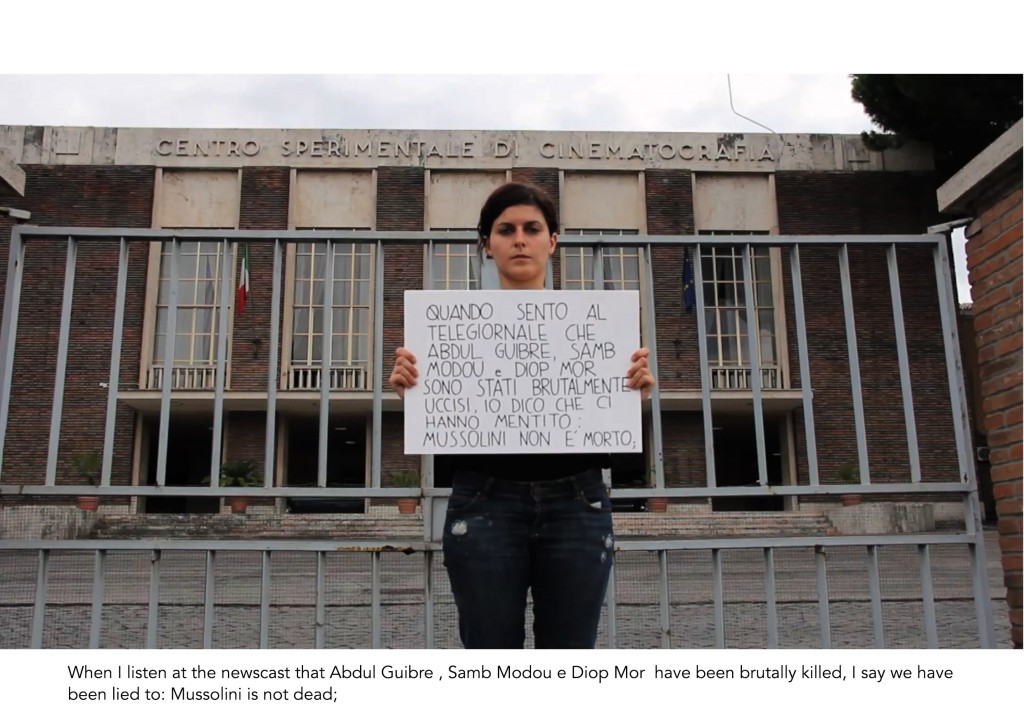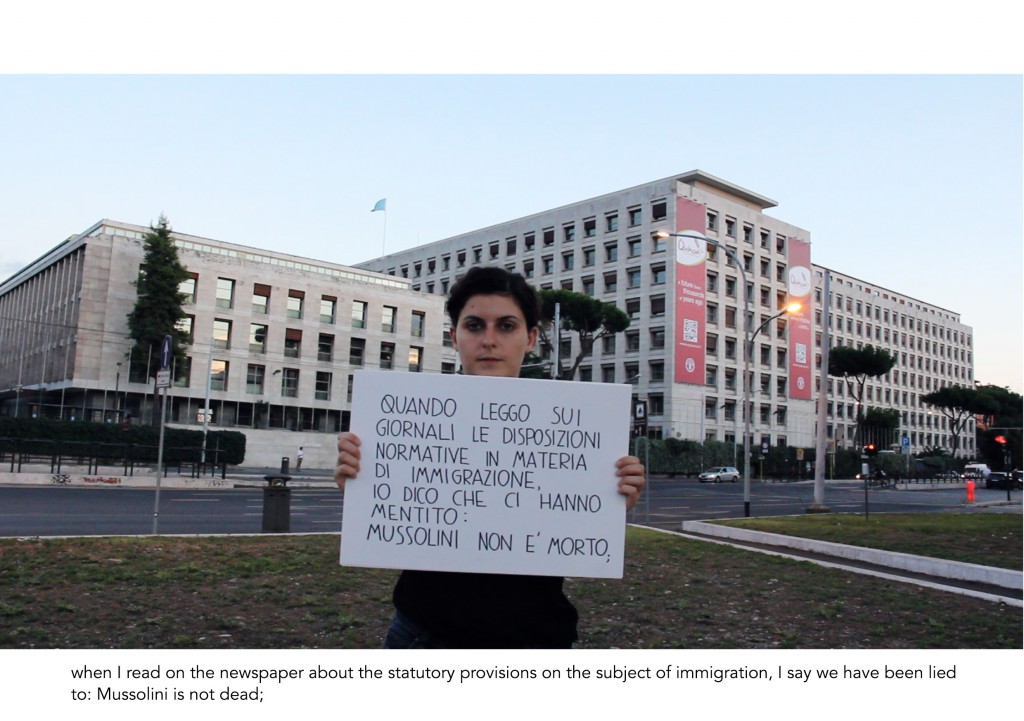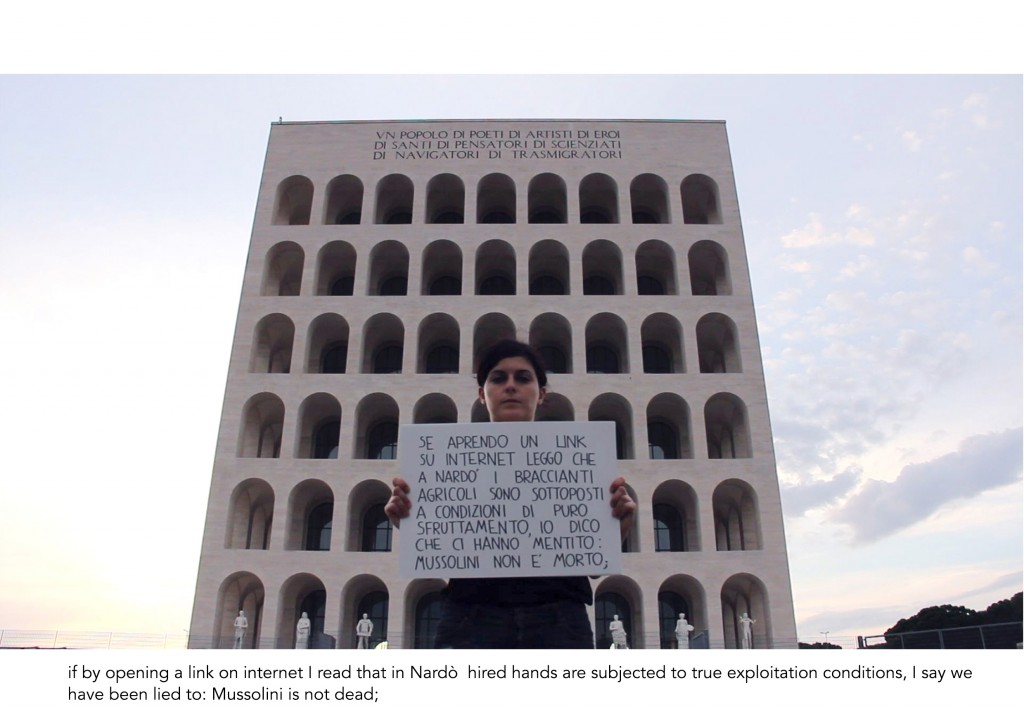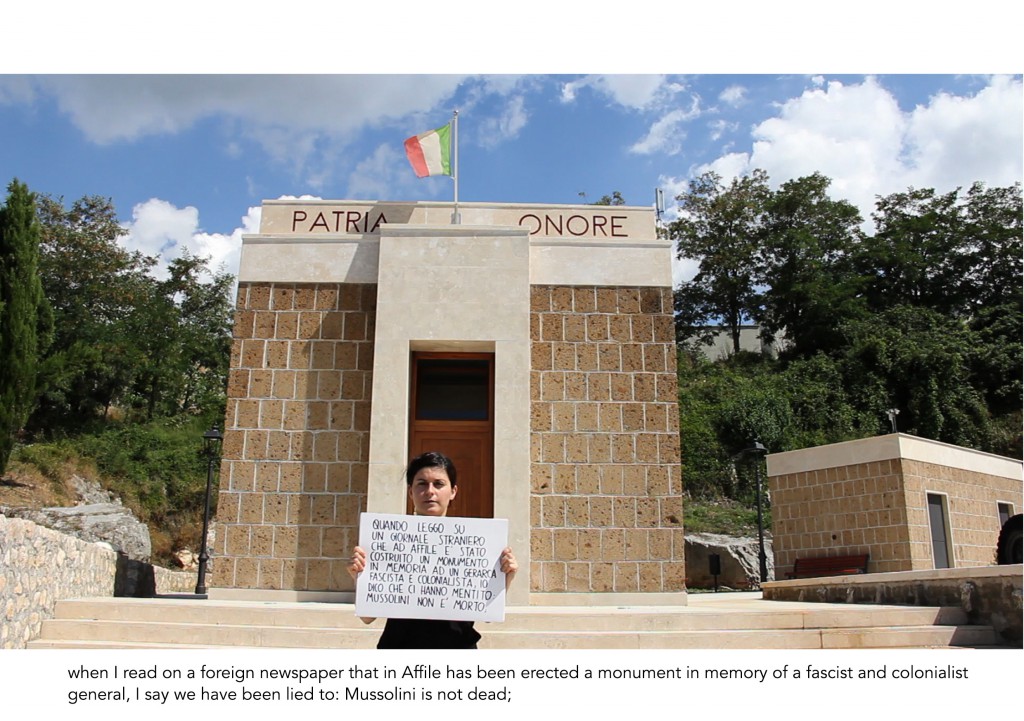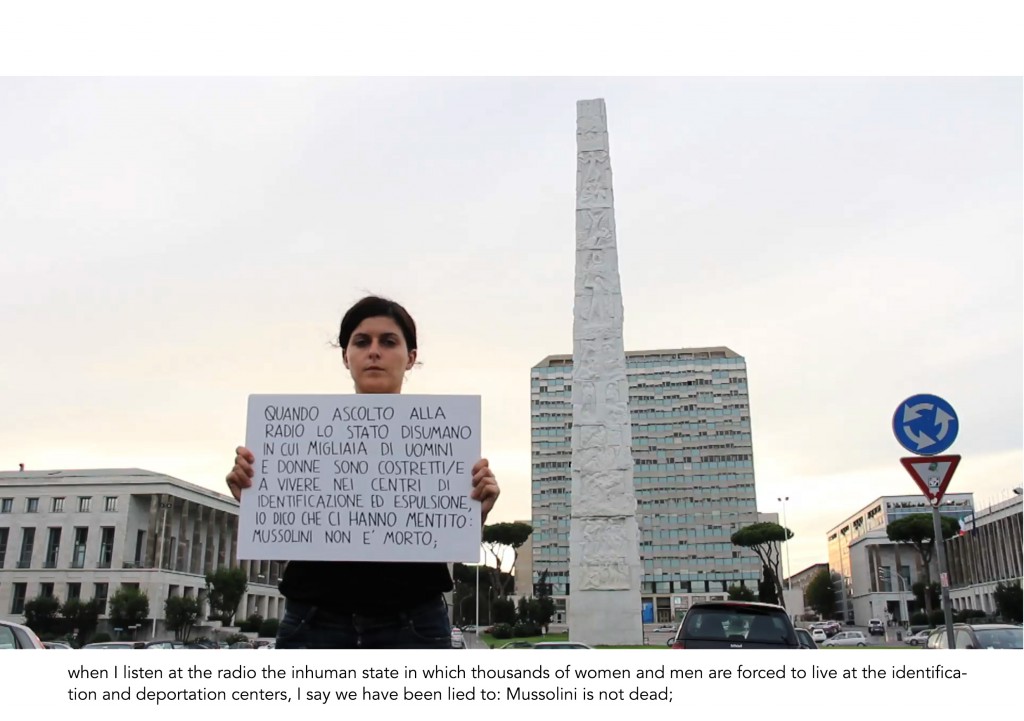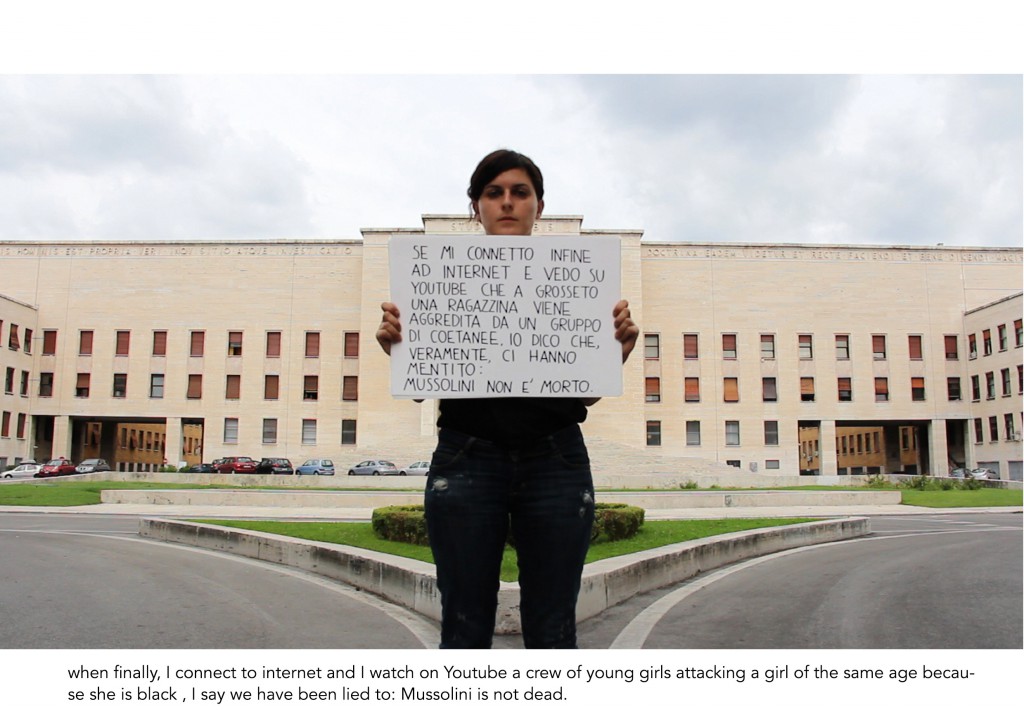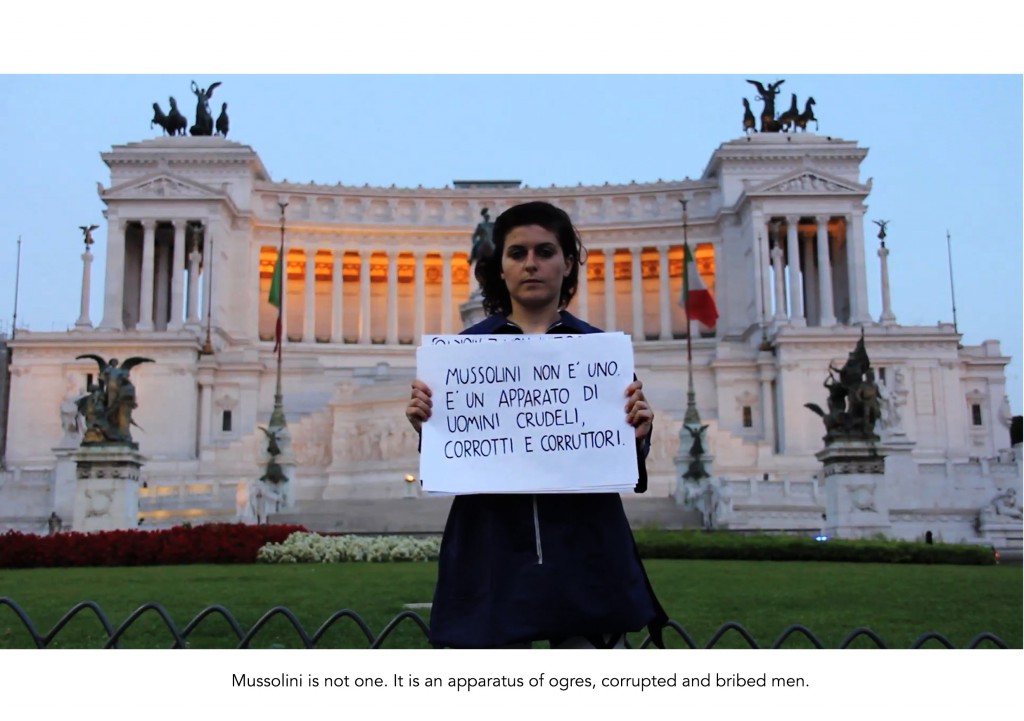A) A proper history retold: STUDYING
In the so-called “Bel Paese” (Italy) we still didn’t deal with the horrors of our past and we still continue to promote forms of oppression toward the non-communitarian subjects and their descendants, also through those forms that appear falsely as innocent and ”positive”. My interest on this thematic rise from the disgust that I feel daily feel by listening to and seeing the Italian State, and the EU supranational apparatus subjugating people, perpetuating inferiorization, racialization and oppression mechanism in contemporary society. There is the urge to remind with no fear, here and now, of what history we are made, while fighting the ignorance that brings us to live in this ill society, in this white supremacist, capitalistic, racist, patriarchal society, as b. hooks would say.
Since I study at the Academy of Fine Arts in Vienna, in the post conceptual art practices lead by Professor Marina Gržinić, I had the chance to develop deeper into issues that were already in my field of interest, from the artistic and, philosophical/ and political point of view. The international context wherein which I found myself, with many worldwide colleagues, has given a fundamental value to this experience. The fact of studying in Vienna, an “imperial” towncity in the middle of Europe, in an elitist institution with exclusive and controlled access, has clashed with the reality of precarious youth many of whichwhom coming from non-EU countries and subjected to the strict Austrian bureaucracy. From the waiting for the visa, that often has postponed their presence in the Academy for at least one semester, to the search for money to show enough economic sustainability, to the never ending procedures in order to live in Austria, etc. During these years we tried in different ways to intervene in the racist structures of the academyAcademy and we used art as a tool to gain these changes, to take back spaces, physical and of thought.
All these forms of institutional racism as well as all other forms of discrimination in Austria are just an example of the dynamics that characterize the Western Europe in its entirety and they are now impregnated within the social, political and economic body of the EU (named the fortress Europe).
B) The political, social and economic situation in Italy
I was born in Acqui Terme, a northern Italian town located in the Piedmont region, into a family of internal immigrants. My parents originate from many generations from Altamura, a town from a Southern region, Puglia.
The process of industrialization, which started with the Italian Unification, had a strong drive, and started after the Second World War, with the introduction of capital to Italy that came in the form of aid for reconstruction. Between 1950 and 1970 there were strong waves of emigration, both external and internal. Many people emigrated to Argentina and Australia, but internal migration to the cities of the industrial North has no precedent in European history because of its vast dimensions[1].
The south, which was committed to agriculture and farming, was considered “under-developed”, “troglodyte”, with a “low cultural coefficient” and a high unemployment rate.
It is clear that the oppression in the colonies was and is perpetuated internally. This situation was excellently described in Frantz Fanon’s work.
With the establishment of the industry a large amount of low cost labour was necessary, so the masses – particularly the men, an exploitable labour force from the South – moved toward the “modern” north. Southern people were ridiculed, exposed, discriminated and segregated, considered dirty and uncivilized. Statements such as “No entry for dogs and southerners”, “Do not rent to the southerners” could be read on the walls of the cities.
At the time, the building sector also had a great success and it is in this working field where my father situated himself. So, at twenty-something, the quasi-strange couple, my parents, moved to Acqui Terme. It is in this city where they decided to stay and give birth to their three children.
I grew up in a city ruled by the Northern League (Lega Nord), a political right-wing party well rooted in the local territories of the northern regions as well as in public institutions (local, national and international). From its formation it has proudly promoted xenophobic and racist sentiments.
I still remember when, years ago the mayor passed a motion that included a downright bounty on Albanians ‘sans-papiers’, which was “awarding” one million liras (Italian currency before the Euro) to those citizens that would report to the authorities an “illegal” migrant.
We are speaking of course precisely about that country, Albania, which was temporarily occupied by Italians in the final stages of World War I (1920) and then conquered militarily by Mussolini in 1939. The Italians, more than 30 thousand, between settlers and workers, who disembarked and occupied Albania, quickly turned the Kingdom of Albania into Italian protectorate.
What was the impact of colonialism in the aftermath of the political situation of the colonized countries?
What is legal and what is illegal? Is it legal for a government or an economic system to continuously and even silently still kill people?
The Northern League is the party responsible that evicted and destroyed many Roma settlements, to have retrieved the usefulness of the crematorium toward Moroccans, to have created games on the internet such as Bounce off the clandestine where the winner is the one who manages to repel the largest number of immigrants, to have compared migrants and black people to animals (it happened recently with the Minister for Integration Cécile Kyenge, the first black woman in the government in Italian history, who since the first day she started work has been subjected to horrible racialised insults, even from colleagues).
Among the bloodiest statements of the Northern League exponents against the minister I can report the following abhorrent insults:
– Dolores Vanlandro on Facebook writes, “Nobody wants to rape her, then she could understand what the victim of such a bloody murder (rape) can feel?[2]“;
-Roberto Calderoni, “When I see pictures of Kyenge I cannot throw the appearance of an orangutan out of my mind[3]“;
-Alessandro Brianza and Edgardo Arosio stated, in reference to what happened at the convention of the Democratic Party (Pd) (where the Minister has been the target of an attack with bananas by Davide Fabbri, a former participant of the reality show Island of the Famous): “If they had thrown coconuts they would have hurt her. So launching the bananas … she must be happy.”
-Moreover Vittorio Milani, a former member of the autonomist movement “Veneto State” wrote on his Facebook profile: “Kyenge says that if we want to remove the burqa, then the nuns have to remove their outfit called a habit, too. This is absurd; someone should kill this bitch, she’s stupid and useless.”[4]
Another threat on Facebook, this time from a man (61 years old) from Verona who in anticipation of the inauguration of the project African Summer School in Verona, attended by the Minister, wrote: “Let’s welcome the nigger minister in Verona with weapons[5]”
The extreme right party Forza Nuova is brutally attacking her. Recently, during another convention that she attended, mannequins spotted with red paint were located next to the stage. Alongside the flyers: “No to the ius soli,[6], immigration kills”. And still a poster appeared on the walls of different cities, from the south to the north, which says: “Immigrants go back to your country! In Italy we’ve lost our jobs, our home, our future”. The statement is even translated in five different languages.
The list of insults and racist acts toward constructed categories of “inferior” people, especially black, Islamic and Roma is endless.
It is annoying to listen to all these disgusting things nevertheless I think that we should remember daily, the hidden background of this system of dismissals, a historical way thinking and of fascist brutalities that still live and reproduce themselves today.
Therefore, it is on such a basis that the politicians and media instigate racial hate by thinking that they have total control on our minds and hearts. Therefore, yes, maybe, to hate but only our fake white racist misogyny.
In the last decade many right wing movements and political parties expanded and increased consensus. Aside the already mentioned Northern League and Forza Nuova, we can list Casa Pound, Fiamma Tricolore, Patria Nostra, Azione sociale (by Alessadra Mussolini), Resistenza Nazionale. Internet as having amplified the effect of spreading their racist ideology through web pages, social networks, forums, etc. Nevertheless they also take over (we can also use the word “curate”) cultural and artistic movements, initiatives, events and various activities. With these they have constructed a very “successful” system in delivering their messages and spreading their ideas. The use of pop-culture in their politics is a sly way to “normalise” cultural, social and aesthetic views of fascism in the public discourses.
One of the movements that struck my attention and the attention of many who are aware of this, what I can term, “FASCISM RELOADED”, is the fast growing “grass-roots” right radical neo-fascist Casa Pound. In the public opinion it became known in 2003 with the squat of a state owned building in the near of the train station Termini with the motivation of helping families who have emergency housing. With this kind of action they contested what they term “reactionary stereotype that the occupation of empty buildings is an exclusive practice of the left.” To understand the big impact that this it has on the social level I want to mention some of the initiatives they developed in these years among which the “Social loan”, a law proposal dedicated to create a regional apparatus with which housing blocks would be built with public money and then sold at the price of the cost of production to “Italian families” (not yet owning any real housing estate). And the project “Time to be mothers” that calls for a reduction of the working hours, from 8 to 6 hours a day, for one of the parents of a child between the ages of 0 to 6, whilst the salary would hold steady. At the moment they also manage a network of bars, libraries, pubs. They even have a theatre company (Teatro Non Conforme FT Marinetti/Nonstandard theatre FT Marinetti), two sport schools and teams, two magazines L’Occidentale/The Western and Fare Quadrato/Close ranks, a web TV channel (TortugaWeb) and a web radio (Radio Bandiera Nera), rehearsal studios, an artistic movement called Turbodinamismo and an association of artists called “Artisti per Casa Pound”. For them in this latter project (I quote and translate from their web site) the “art is mainly ‘political’ in the sense that it has always the feet firmly knock in the life of the polis, from which it draws its nourishment and which gives it the fundamental orientation.”
This calls to rethink political art and the vocabulary we use and the differences we established.
I believe that this list of information can make us more aware of the worrisome status of how fascist ideology is penetrating the life of many without a historical memory. Fascism is there but without history of earlier historical Fascism and it is presenting itself as a populist movement to make the life of Italians ( and we can state in blood and soul with a clear racist ground) “just” better.
In their program they have been appropriating concepts, vocabulary and causes that are part of the once clear leftist struggles. But the right of housing, the fight against the financial dictates and privatization is done by reinforcing nationalism and racism, preached through radical contrast to immigration mechanisms.
Antar Marincola says: “The right wing still exists and it will always exist. You can always create the burden of the migrant, just as the Italians are linked to the mafia and spaghetti: the stereotype. That will always exist. The Moroccan drug dealer, the Somali criminal, and so on. This thing enters in the emigration and immigration logic. The right wing is omnipresent; they will always be by your side. This is a certainty in western countries.
But what do the leftists do in this regard? What kind of other politics? What kind of integration do they do? In which kind of processes are they involved? Which kinds of inclusion mechanisms do they develop? What kind of prospects do they have according to the world that they are controlling and managing? What is the European left-wing doing for real integration? The right wing has always done its job and it will do it better and better, especially in times of crisis like this, it will do it doubly better, but where is the left? Where has it been? Who created the detention centres for migrants, the Bossi-Fini or the Turco-Napolitano law?”
Igiaba Scego says: “I was very impressed by the Dominican American writer, Junot Díaz, who said that we must decolonise love. This is a strong statement because we have very unbalanced relationships between employer and employee, or between members of the same family or even for a couple. I think that to decolonise love, affections and the labour relationships is absolutely important. We must begin to tell the truth, to scatter these alleged inferiorities and superiorities.
We have to, and I’ve thought about this for quite some time, to decolonize Italian politics because it is full of stereotypes. It ranges from the hatred of the Northern League – “We don’t want these King Kong people, they should return to their countries!”, a rhetoric we have lived with for twenty years and more – to paternalism.
I believe that the Italian leftists or Italian progressivists have to decolonise their relationship with the migrants and migrants’ children because personally I’m tired of always being considered the victim, -I’m not a victim at all – or who claims to speak in my voice – I have my voice and I can speak for myself – and then above all the debate on “ious solis” makes me want to vomit because for many years they just speak about making a law, which is rather simple.
We are beyond paternalism. This means to not understand that your country is anthropologically changed because there has been a very strong change.
Then we always talk about children when the problem also affects people of my age – next year I will be 40 – I was not born yesterday, I’m the daughter of immigrants, I’m Italian and Somali, so let’s stop talking only about children, we are both children and adults, soon we will be the elderly, we would need to talk about our pensions. Politics stewed me greatly and then also the rhetoric of embracing black children to show that we are so progressive etc. No, there is no need for exterior superficialities, we need stability and facts.”
[1] For more information look at the A.S.E.I. (Historical Archive on Italian Emigration) web site: http://www.asei.eu/it/archivi/
[2] Original quote: “Ma mai nessuno che la stupri così tanto per capire cosa può provare la vittima di questo efferato reato?”.
[3] Original quote: “Quando la vedo non posso non pensare a un orango”
[4] Original quote: “La Kyenge dice che se vogliamo eliminare il burqa anche le suore si devono tagliare il velo. Siamo all’assurdo, qualcuno uccida questa p… idiota e inutile”.
[5] Original quote: “Accogliamo la ministra negra con le armi a Verona”.
[6] The Ius Soli is the condition that guarantees the citizenship to those children born in the territory of that State, regardless of the nationality possessed by the parents. At the moment in Italy the citizenship is given through the principle of the ius sanguinis that means by blood lineage.
C) Intervention in spaces of amnesia
The 2013’s Italy is a country in deep crisis: economic, political, social and of thought/action.
It is especially in such moments that violent and repressive episodes, security and control mechanisms, diverse forms of extremism, intensify.
It is a country that search for easy targets on which to point the finger by omitting an in-depth analysis of the causes that lead us to live in this sick society.
Everything becomes a commodity. Education, relationships, knowledge, culture, experience, bodies, cells, sex, health and damages. Life and death.
Separated, isolated, depoliticized this is how the system wants us.
Subjected to the recruitment of puppet troops. Sometimes forced, sometimes volunteer.
All in the name of democracy.
Maybe it is time to re-democratizing democracy? Overcoming democracy? Re-inventing democracy?
How can one still speak of democracy in Western society when it feeds inequality, de jure and de facto, of parts of the population? Are there wo/men that are more equal than others?
Monsters are hidden in the closets, the horrors of the past.
We still didn’t deal with colonialism, nonetheless with fascism.
Living deads, as Achille Mbembe would say, are multiplying in our homes, streets, beds, schools and offices.
Void and deprived beings, easy to fill with slogans and false promises.
If it is not physical death that we are subjected to, it is certainly that of our rights. Especially for those who are oppressed from Fortress Europe.
Which rights? Our rights!
The bureaucracy, the denial and the oblivion are just as repressive forms as physical violence.
“When I turn on my radio, when I hear that Negroes have been lynched in America, I say that we have been lied to: Hitler is not dead; when I turn on my radio, when I learn that Jews have been insulted, mistreated, persecuted, I say that we have been lied to: Hitler is not dead; when finally, I turn on my radio and hear that in Africa forced labor has been inaugurated and legalized, I say that we have certainly been lied to: Hitler is not dead.”
Discours politiques, election campaign of 1945, Fort- de-France, Aime Césaire. From Black Skin, White Masks, p. 90, Franz Fanon.
1. When I listen at the newscast that Abdul Guibre[1], Samb Modou e Diop Mor[2] have been brutally killed, I say we have been lied to: Mussolini is not dead; 2. when I read on the newspaper about the statutory provisions on the subject of immigration, I say we have been lied to: Mussolini is not dead; 3. if by opening a link on internet I read that in Nardò[3] hired hands are subjected to true exploitation conditions, I say we have been lied to: Mussolini is not dead; 4. when I read on a foreign newspaper that in Affile has been erected a monument in memory of a fascist and colonialist general, I say we have been lied to: Mussolini is not dead; 5. when I listen at the radio the inhuman state in which thousands of women and men are forced to live at the identification and deportation centers, I say we have been lied to: Mussolini is not dead; 6. when finally, I connect to internet and I watch on Youtube a crew of young girls attacking a girl of the same age because she is black[4], I say we have been lied to: Mussolini is not dead. 7. Mussolini is not one. It is an apparatus of ogres, corrupted and bribed men.
Here below the pictures of the intervention in spaces of amnesia.
Which locations did I choose for these pictures?
1. EXPERIMENTAL FILM CENTER || The Experimental film center or Italian National film school was established in 1935 in Italy and aims to promote the art and technique of cinematography and film. It is the oldest film school in Western Europe, founded in the city of Rome in 1935 during the Benito Mussolini era by his head of cinema Luigi Freddi, was and is still financed by the Italian government and focuses on education, research, publication and theory. From the very beginning this institution worked very closely to Cinecittà and Istituto Luce, which are located in the same quarter[5].
Cinecittà is a large film studio in Rome that is considered the hub of Italian cinema. The studios were founded in 1937 by Benito Mussolini, his son Vittorio, and his head of cinema Luigi Freddi for propaganda purposes, under the slogan “Il cinema è l’arma più forte” (Cinema is the most powerful weapon)[6].
The Istituto Luce (Cinematography Educational Union) is a public institution devoted to film distribution for educational and informative purposes. Born in Italy in 1924, the Istituto Luce quickly became a powerful propaganda tool of the fascist regime. The Luce was instituted by Benito Mussolini by the Royal Decree-Law No. 1985 of 5th November 1925. In July 1925, the Presidency of the Council of Ministers was branching out a circular to the Ministers of the Interior, Education, Economy and Colonies inviting them to rely exclusively on the technical organization of the Luce for educational and propagandistic purposes.[7]
2. EX MINISTRY OF ITALIAN AFRICA || This building was designed at the end of the thirties (1930s) to host the Ministry of the Colonies, a department of the Italian Government of the Kingdom of Italy, with expertise on the administration of colonial possessions. It was established on the 20th of November 1912 by the Royal Decree no. 1205. It was in charge of governing the Italian colonies by governors and to direct the economy of the colonies. With the Royal Decree no. 431 of the 8th of April 1937 following the Italian conquest of Ethiopia and the birth of the Italian East Africa the ministry was renamed the “Ministry of Italian Africa”. It was abolished on 19 April 1953 by the law no. 430 of. Since then it is occupied by FAO (The Food and Agriculture Organization of the United Nations). FAO was established on 16 October 1945, in Quebec City, Quebec, Canada. In 1951, its headquarters were moved from Washington., United States, to Rome, Italy.[8]
In 1937 it was erected in front of the Ministry for Italian Africa the Obelisk of Axum, taken as war booty and moved to Italy by the Fascist regime, which wanted to commemorate the conquest of Ethiopia and the birth of the ephemeral “new Roman empire”. It was officially unveiled on October 28th 1937 to commemorate the 15th anniversary of the March on Rome.
In 1947with an UN agreement, Italy agreed to return what was stolen to Ethiopia.
It took more than 50 years to return the Obelisk to Ethiopia. The final piece was returned on 25 April 2005.
3. EX IMPERIAL SQUARE / GUGLIELMO MARCONI OBELISK || Arturo Dazzi was commissioned by Mussolini in 1937 for the realization of the monument to be erected in honor to Guglielmo Marconi. The location chosen was at the central area of EUR, in particular at the then called Imperial Square. Now Piazza Guglielmo Marconi, which is surrounded by four Museums: of Ethnography, the Academy of Sciences, of Ancient Art and of Modern Art. The work was to be completed by 1942, with a view to the Roma Universal Exhibition, and
Marconi was addressed by the fascist propaganda as an example of patriotism and “genialità italica” (italic genius). Benito Mussolini, in a speech to the Senate on the 9th December 1937, stated: “No wonder if Marconi embraced, since the first day, the doctrine of the Blackshirts, who are proud to have him in their ranks.[9]” On the other hand Marconi did not hide his sympathies for the regime, saying: “I claim the honor to be the first fascist, in the field of radiotelegraphy, to recognize the usefulness of bringing together in a “fascio[10]” (bundle) the electric rays, as Mussolini was the first to recognize in the political arena the need to bring together in a “fascio” (bunch) the healthy energies of the Country for the grandeur of Italy. [11]”
4. RODOLFO GRAZIANI MEMORIAL || It is a monument that was built in August 2012 in Affile, Roma’s province, in memory to the fascist colonialist general Rodolfo Graziani. In the following paragraphs you will find more information about it.
5. THE PALACE OF LABOUR CIVILIZATION || It is also referred as Squared Colosseum as conceptually reminiscent of the Flavian Amphitheatre (Colosseum).
The palace, a large business center and suburban complex, was initiated in 1935 by Benito Mussolini for the planned 1942 world exhibition and as a symbol of fascism for the world. The Palazzo was designed by the architects Giovanni Guerrini, Ernesto Bruno La Padula and Mario Romano and constructed between 1938 and 1943. It was inaugurated on 30 November 1940 as the centerpiece of the Esposizione and continues to be its most iconic building. The structure is also considered one of the most representative examples of Fascist architecture at the EUR[12].
The Palace of Labour Civilization and the ex-Imperial square / Guglielmo Marconi Obelisk are located in EUR. EUR, which stands for Universal Exposition of Rome, is a complex urban and architectural heritage of Rome, the 32nd district of Rome, now called Europe neighborhood. The complex, built by Benito Mussolini, was designed in the thirties in anticipation of the “Exposition Universelle”, to be held in the capital in 1942 to celebrate the twentieth anniversary of the March on Rome, never carried out because of the war. It should have been the “Olympics of Civilization” headquarter and the new center of Rome.
The EUR provides a large-scale image of how urban Italy might have looked if the fascist regime had not fallen during the war—large, symmetrical streets and austere buildings of limestone, tuff and marble, in either stile Littorio, inspired by ancient Roman architecture, or Rationalism. Its architectural style is often called simplified neoclassicism. The event had clearly propaganda wills: it was intended to demonstrate at the international level, on the twentieth anniversary of the March on Rome by Benito Mussolini, the historical, artistic, scientific and political superiority of fascist’s Italy.
6. LA SAPIENZA UNIVERSITY – RECTORATE || The campus has been produced by a number of rationalists’ architects during the thirties, in the midst of Italy’s fascist era . The architectural project, strongly supported by Mussolini so that also the capital of Italy could have its university center, was part of the restoration work that involved the whole city until the Second World War. The campus was inaugurated on 31 March 1935 in the presence of King Vittorio Emanuele III.
7. ALTAR OF THE FATHERLAND || The Vittoriano, also known as Altare della patria (Homeland Altar), or Monumento Nazionale a Vittorio Emanuele II (National Monument to Victor Emmanuel II) is a monument built in honour of Vittorio Emanuele, the first king of unified Italy. It was inaugurated in 1911 and completed in 1925. It is located in Rome and it overlooks the Piazza Venezia.
Benito Mussolini had his office in the Palazzo Venezia in the Sala del Mappamondo, and used its balcony overlooking the Piazza Venezia to deliver many of his most notable speeches, such as the declaration of the Italian Empire, 9 May 1936, to the crowds gathered in Piazza Venezia.
[1] Abdul Salam Guibre is a young black guy with Italian citizenship and origin from Burkina Faso, which was accused by the owners of a kiosk in Milano to have still a packet of biscuits and for this reason beaten to death by them. The father and son owners called Abdul Salam Guibre a “dirty nigger” and attacked him with a metal pole.
[2] Samb Modou and Diop Mor are two market traders with origin from Senegal whom were killed on 13 December 2011 in Florence by Gianluca Casseri, the killer shot himself dead as he was approached by police in a car park. The attack was racially motivated according to authorities. Casseri allegedly had relations with the extreme right group Casa Pound.
[3] Nardò is a village in the Puglia region where thousands of migrants’ workers are hired in the agriculture sector with terrible conditions, both concerning payments and living conditions.
On the 31st of July 2011 a group of workers started, in Nardò, a strike that was the first spontaneous and completely self-managed migrant farm workers strike in Italy.
[4] This face happened in Grosseto (Tuscany), in February 2013, when a group of young girls persecuted and finally attacked a peer because accused to be black.
[5] Info taken from http://en.wikipedia.org/wiki/Centro_Sperimentale_di_Cinematografia and the Experimental Film Center web site: http://www.snc.it
[6] Info taken from http://en.wikipedia.org/wiki/Cinecittà and Cinecittà website: http://www.cinecittastudios.it
[7] Info taken from http://it.wikipedia.org/wiki/Istituto_Luce and the Istituto Luce web site: http://www.archivioluce.com/archivio/
[8] Info taken from http://it.wikipedia.org/wiki/Ministero_delle_Colonie
[9] Original quote: “Nessuna meraviglia che Marconi abbracciasse, sin dalla vigilia, la dottrina delle Camicie Nere, orgogliose di averlo nei loro ranghi”
[10] Here the symbolic use of the word “fascio” is connected directly with the fascist emblem.
[11] Original quote: “Rivendico l’onore di essere stato in radiotelegrafia il primo fascista, il primo a riconoscere l’utilità di riunire in fascio i raggi elettrici, come Mussolini ha riconosciuto per primo in campo politico la necessità di riunire in fascio le energie sane del Paese per la maggiore grandezza d’Italia”.
[12] Info taken from http://en.wikipedia.org/wiki/Palazzo_della_Civiltà_Italiana
